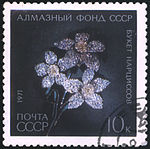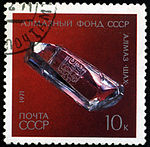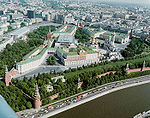- Diamond Fund
-
Coordinates: 55°44′58″N 37°36′49″E / 55.74944°N 37.61361°E Diamond Fund (Russian: Алмазный фонд) is a unique collection of gems, jewelry and natural nuggets, stored and exhibited in Moscow Kremlin, Russia. The Fund dates back to the Russian Crown treasury instituted by emperor Peter I of Russia in 1719.
Contents
History
Imperial treasury
Peter's gem collection, established in 1719, was later stored in the Diamond Chamber (Бриллиантовая комната) in the Winter Palace. All succeeding monarchs added their contributions to the Chamber; a 1922 study by Alexander Fersman identified 85% of all exhibits to 1719-1855 (from Peter I to Nicholas I) and only 15% for the last three emperors.
Soviet Union
Preservation, sales and looting of imperial treasures after the Russian Revolution of 1917 is a matter of controversy and speculation. The Imperial collection was moved from Saint Petersburg to Moscow during World War I; the Soviet Diamond Fund was officially established in 1922 (official site). The treasure was first exhibited to the public in November 1967. Originally a short-term show, in 1968 it became a permanent exhibition.
Russian Federation
The Russian State retains the monopoly for mining and distribution of gemstones, as set by the 1998 law "On precious metals and precious stones". Diamond Fund operations are regulated by the 1999 presidential decree (official text). The Diamond Fund is part of a larger State Fund of Precious Stones, managed by the Ministry of Finance, and accumulates the most valuable items, in particular
- All raw diamonds exceeding 50 carats (10 g)
- All cut diamonds exceeding 20 carats (4 g), cut diamonds of exceptional quality exceeding 6 carats (1.2 g)
- All raw emeralds, rubies, sapphires exceeding 30 carats (6 g) raw or 20 carats (4 g) cut
- Unique nuggets, amber, pearl and jewellery
The public exhibits in Moscow Kremlin are only a fraction of Diamond Treasure, handpicked by the Ministry of Finance, which also manages state copyright for images of these treasures.
Recent additions
- 2006 - "The Creator" (Творец), mined in Yakutia in 2004. Third largest raw diamond in the Fund, 298.48 carats (59.696 g) www.rian.ru
- 2003 - golden nugget, 33 kg
- 1989 - "Alexander Pushkin", second-largest raw diamond, 320.65 carats (64.130 g)
- 1980 - "XXVI Congress of CPSU", largest raw diamond, 342.50 carats (68.500 g)
See also (Russian): Complete list of named Yakutian diamonds, 1959–1999, official site of Alrosa mining company www.alrosa.ru
Major exhibits
Seven Historical Gems
- Orlov diamond (photograph) 189.62 carats (37.924 g)
- Shah diamond 88.7 carats (17.7 g), first inscription dated 1591, a gift of Persian Shakh in 1829
- Flat portrait diamond, 25 carats (5 g)
- Red spinel, attached to the Imperial Crown of Russia, 398.72 carats (79.744 g) purchased in China in 1676
- Sapphire, 260.37 carats (52.074 g) photograph
- Columbian emerald, 136.25 carats (27.250 g)
- Olive-green chrysolite, 192.6 carats (38.52 g)
Crowns of Russia
- Imperial Crown of Russia made for Catherine II, 1762
Jewellery
Nuggets
- "The Great Triangle", gold, 36.2 kg, (mined in 1842 in Miass)
- "The Camel", gold, 9.28 kg
- "Mephisto", gold, 20.25 g (mined in 1944 in Kolyma)
Public access
The Diamond Fund is exhibited in the Kremlin Armoury building. It is accessible only through guided tours of fixed duration. Tours in Russian only are organized daily, 10AM-2PM and 3-5PM at twenty minutes interval. Tickets are sold in the lobby of the Fund, advance bookings preferred.
External links
- Russian: Official site of the Diamond fund at www.minfin.ru
- Russian: Official access timetable
- English: Travel Guide to the Kremlin Armoury and Diamond Fund
- History of the Diamond Fund from the Alexander Palace Website
Categories:- Russian monarchy
- Museums in Moscow
- Moscow Kremlin
Wikimedia Foundation. 2010.



